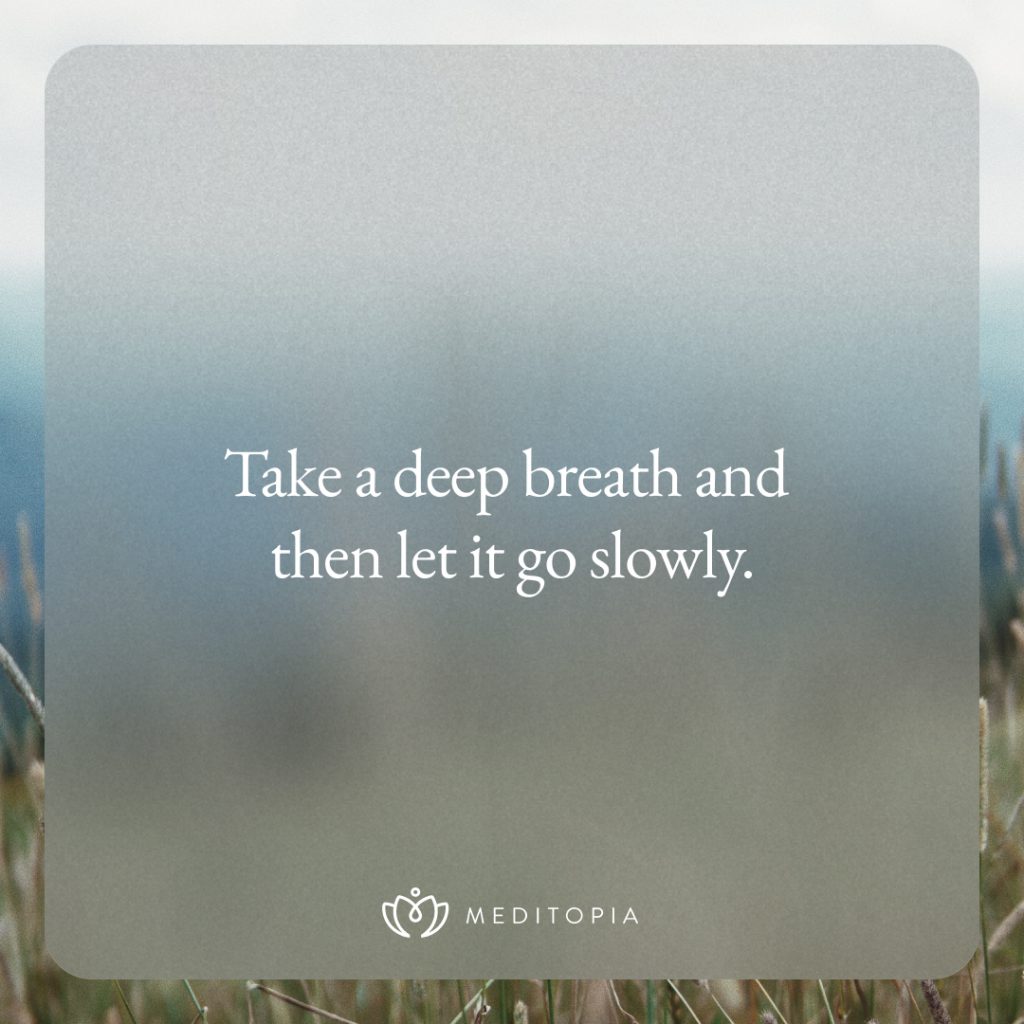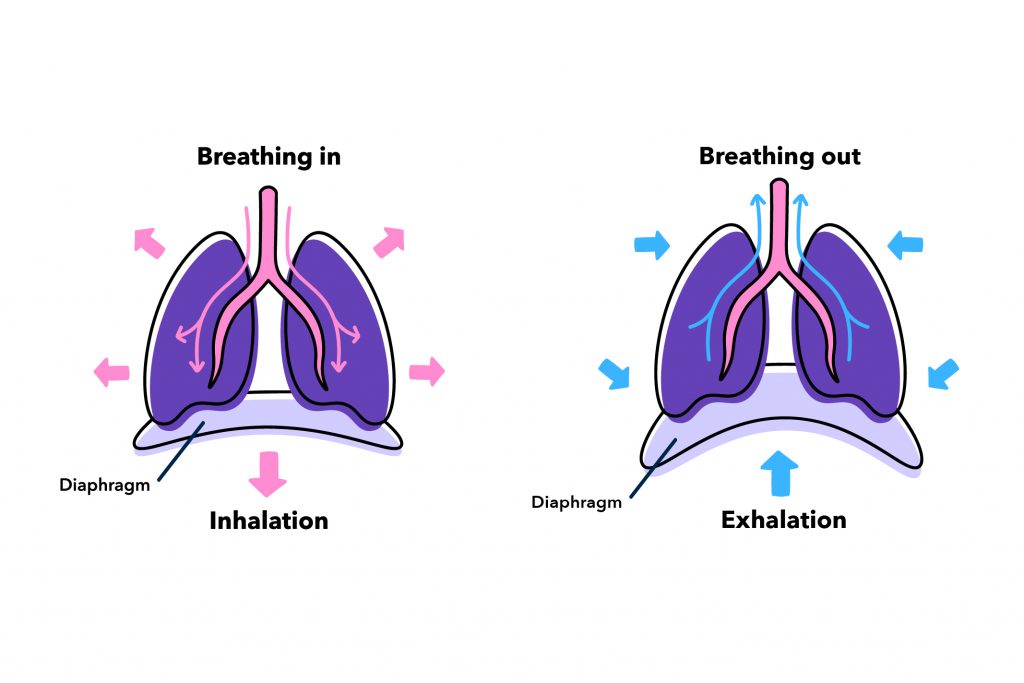Discover Diaphragmatic Breathing!

Content
Often, when considering mindfulness practices, we emphasize the importance of our breath. We ask ourselves to observe it, to be present in it, and to choose it as our anchor, keeping us from drifting too far out of the moment into our thoughts. Have you ever wondered why there’s such an emphasis on the breath?
In the teachings of Zen Buddhism, the sitting meditation is practiced with breath and only breath. We don’t force our breathing into a particular pattern at first, but rather simply observe its natural flow. When our focus is on our breath, we then aim to begin detaching from our thoughts, staying present. This first step, described as an awareness of the “waves of the mind” in Shunryu Suzuki’s book, Zen Mind, Beginner’s Mind allows us to think of our breath like the waves of the ocean.
By doing so, we can imagine that when there’s a hurricane in the middle of the ocean of our minds, we may experience bigger waves, rapidly crashing against our shores. Therefore, the shore reflects what’s happening in the ocean. The waves change depending on the time of day or throughout the different seasons. Similarly, our mind’s response fluctuates depending on when we’re calm, angry, how we slept, what we eat, or how we feel in general. And so, what you’re feeling both emotionally and physically impacts the way you breathe.
The human experience is wildly complex. Tens of thousands of neurons fire at every moment, your skin — the biggest organ in your body — collects information every second through your senses and you’re full of emotions and thoughts at any given moment. We are our own ecosystem with properties like the wind, salt, and ships sailing through our waters. It would be impossible to try to investigate and change every part of ourselves, right? So, what we can do is sit and observe how the waves come and go and watch as changes unfold in our own personal sea.
In our practice, we set an intention to be aware of the flow of our breath. By doing so, we aim to quiet our active thoughts, opening up space where we can coexist alongside them in the present moment. Creating such a space for ourselves can have certain benefits like reducing symptoms of anxiety, improving the quality of our sleep, and alleviating stress. Let’s take a closer look at how the anatomy of the breath relates to those benefits.

The Secret of a Baby’s Breath
One of the most natural breaths you can observe is a baby’s breath. Why’s that? When we’re in the womb, we’re coming into some of our vital functions. We breathe in liquid like a fish in the sea. A baby, because of its physiology and its newly developed brain, is a very impulsive being who’s only reacting to immediate needs.
When a baby is hungry, they may cry out to be fed. Or, if they’re sleepy, they sleep. Sounds a lot like living in the moment, being present in your body, huh?
A baby also lacks experiences, accumulated thoughts, and lessons. Of course, that’s mainly because a little human hasn’t developed some linguistic or neurological skills yet. So, they cannot process positive or negative thoughts yet and they don’t collect memories the ways in which we do. A baby’s mind is clear. We’ll dive deeper into the relationship between the breath and a fresh, clear mind.
Often, if you observe a newly born human, you’ll notice their belly. As the baby breathes, their belly softly rises and falls along with their breath. This kind of breathing pattern isn’t just within babies, of course, for this may be something you experience when you’re lying down or relaxed. You may have heard the term “Diaphragmatic Breathing,” described as belly breathing. That definition is partly true, but to explain it fully, we need to talk about some of the physics behind breathing first.
Physiology of the Breath
In our torso, our lungs and heart are located in the upper section of our rib cage, separated from other internal organs in the lower section by a muscle known as our diaphragm. You can think of this muscle like a curtain dividing a room in two.
When you breathe in, your lungs expand like a balloon, creating space for the rib cage to expand as well. As the lungs and rib cage expand, the diaphragm gets pushed downward.

And this downward push causes the belly to expand to your sides, kind of like when you sit on a balloon or a pilates ball. The deeper our breath, the more effectively we utilize our lung capacity. If our breathing is shallow, this expansion is negligible. So, when people think of “diaphragmatic breathing”, they usually mistake it for breathing into the belly. As breathing with the belly is physically impossible, we know that can’t be true. The diaphragm is actually always a part of the breathing process! We can simply deepen our breaths, utilizing the full capacity of our lungs when we focus our attention on diaphragmatic movement.
How Do We Deepen Our Breath Through Diaphragmatic Breathing?
The best way to apply this technique is to lie down on your back, relaxing your shoulders as you let your arms and feet fall wide in a comfortable position. Make sure your neck, back, and hips are as relaxed as possible.
Now, slowly start bringing your attention to your breath. Try and observe how your belly movement changes with each exhale and inhale for a minute or so. Then, intentionally tighten your abdominal muscles suddenly as if someone were about to punch you and then release and relax those muscles. Do this a couple more times. Then, you’ll try to mimic the movement when you release your stomach when you’re already relaxed. To do this, you can try to push into your abdomen with your fingers to see if your muscles are still stiff or if they’re soft and relaxed.
After making sure that your tummy is soft. Start taking a long, deep breath. You can even put your palm on your belly to see if it rises. As you continue breathing, try to elongate and deepen your inhales and exhales. After you get used to breathing deeply, you can try to breathe as if you’re inflating your tummy, but the key is to do so without tensing the abdominal muscles.
How Does Stress Impact Your Body?
In short, stress can cause tightness in our abdominal area. Often, when we’re stressed, we flex our stomach muscles on instinct.

Evolutionarily, we have the tendency to tone and shorten the abdominal muscles as these house some of the most vulnerable and vital organs. So when we’re afraid, feel threatened or intimidated, our nervous system interprets the situation as an issue of survival and we contract the abdomen. In many cases the “stress” we experience in daily life stems from those kinds of emotions or thoughts.
Stress is an organism’s response to its surroundings, often the motivator to seek shelter or find food. As a more modern example: Some level of stress is needed for you to complete tasks at your job, however when the optimal point is exceeded and more stress related hormones are released or other physiological reactions occur, that state starts to become harmful and results in feeling “stressed out”. If this state persists, that can lead to what we call “burnout syndrome” or other stress-related disorders. Usually, persisting stress results in physical discomforts such as pain in various areas of the body like your chest, back, or neck, or headaches, heartburn, and more.
How Can Diaphragmatic Breathing Help with Stress?
Luckily, we can make use of our breathing in order to alleviate those symptoms to some extent. Our bodies work with our minds on a feedback loop of sorts. So, how you think and respond to stress can impact how your body processes it. For example: if you lie completely still for a couple of minutes when you don’t feel sleepy, your brain starts to think that you’re sleeping, beginning to create the ideal conditions to do so. Then, you get sleepy and eventually fall asleep.
So, if you maintain relaxation throughout your muscles, posture, and breath, eventually the message that you’re relaxed reaches your nervous system. A relaxed nervous system can impact your mood and your mental state. What’s more, when the fight or flight response of the nervous system is active, we tend to take short, rapid breaths. This reaction to fight or flee is related to the sympathetic nervous system and often activates in times of stress. When your belly is soft, your breaths are steady and elongated and the fight or flight response of the nervous system automatically switches off.
How Can Diaphragmatic Breathing Help With Sleep?
Sleeping issues can present themselves for a variety of reasons and are often caused due to increased brain activity. In our daily lives, we’re typically already on alert because of the amount of time we spend on screens. Getting too much artificial light, especially if we’re not moving our bodies now and again, can throw off the way our bodies process sleep hormones.
Another reason our brain might be a bit overactive is our thoughts. Maybe your thoughts are racing and you can’t seem to fall asleep. Those thoughts may be related to something that happened in the past or hypothetical situations that may take place in the future. Does that sound familiar to you?

This active state of the brain is again related to stress hormones and the sympathetic nerves. If you experience a lack of sleep due to thought activity, you may have found it nearly impossible to put a stop to the train of your thoughts or to come up with satisfying answers to your 3:00 AM “what-if” questions…
What you can do is to try the diaphragmatic breathing technique for at least a couple of minutes. The key here is not to lose focus on your body and your breath. It may not work like magic, but if you implement it regularly you may start to develop a deeper sense of self-awareness. The more you practice this exercise, the easier it will become to relax your body and mind.
Even if you don’t experience this thought activity but still have trouble sleeping, this deep breathing technique can help you by gradually relaxing your body.
How Can Diaphragmatic Breathing Help With Anxiety?
We hear the word “anxiety” being used in our daily language more and more. Anxiety can present itself in response to various stimuli and each person experiences it differently. Maybe you get anxious in the city if you’re feeling disconnected from nature or perhaps the higher concentration of people brings about social anxiety. Or maybe the isolation from the pandemic or the increased screen time has you feeling anxious. What we actually mean by “anxiety” is that it encompasses a wide range of differing experiences and more people experience it every day.
Sometimes we may view being overly worried or anxious as temporary states. However, sometimes the stress of our every day can make it feel impossible to get ourselves out of this kind of cyclical thinking. We may feel stuck and begin to experience physical symptoms as well from shaking to sweating, dizziness, brain fog, to nausea, and so on.
Often, the underlying need beneath our anxious thoughts is a desire for security. When we don’t feel safe, we tend to hold onto negative thoughts and scenarios. We may get so swept up in our perception of reality, that we overlook or ignore our actual needs. The mind may produce thoughts and endless possibilities and if we disconnect from our emotions and needs, we can mistake this distorted reality as real. It then becomes nearly impossible to take a step back and see things clearly. So, we start to shape our world based on those uncomfortable thoughts.
Further, your body can also react and respond based on that distorted reality. Imagine that you have an argument with your partner in your head and your body reacts as if you’re feeling real anger. Your heart rate begins to increase, your chest tightens, and adrenaline is released. Does it make sense now that you may experience symptoms of anxiety when you get lost in your thoughts without realizing it?
So, the first thing to address is the emotional need within. Ask yourself, “What do I need at this moment?” or, “Which of my needs is most often being neglected when I experience anxiety?” To soothe those emotions and calm your nervous system, you now know how crucial breathing can be. When experiencing acute symptoms, it may not be realistic to apply any breathing techniques in the moment. However, you can try to keep your attention on your breath, attempting to deepen it. When you’re feeling a bit steadier, you can practice diaphragm breathing regularly. The more you practice, the easier it will be to access this technique in those more difficult moments. Don’t forget, you’re actually training a muscle! It’s like lifting weights in the gym and using that muscle when in an emergency situation in your daily life.
Do you see diaphragmatic breathing differently after reading this article? Have you practiced diaphragmatic breathing before? Do you think that you can benefit from it? If so, please share your thoughts and experience with us!


